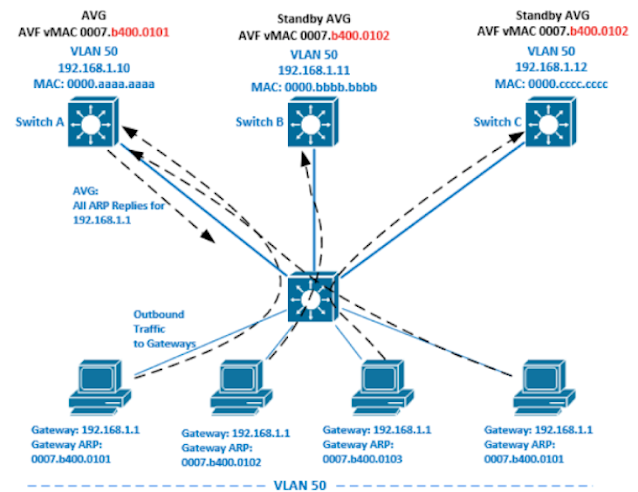Introduction to GLBP (Gateway load balancing protocol)
Introduction to GLBP (Gateway load balancing protocol)
Gateway load balancing protocol performs similar function to HSRP and VRRP. In both HSRP and VRRP, group of routers participating in first hop-redundancy has one Active and can have multiple Client routers. At one single time, traffic is being passed through Active router, leaving client routers with unused bandwidth.
Client routers will only become active once Active router in a group fails. We can create multiple groups and create different active routers but it results in extra administrative burden.
GLBP on the other hand can provide load balancing over multiple routers (gateways) using a Single Virtual IP and multiple Virtual mac-addresses. The bandwidth/traffic load is shared between multiple routers participating in the group rather than being handled by a single active router.
Following are the important points conceptually for GLBP.
R2(config-if)# glbp 1 load-balancing ?
host-dependent Load balance equally, source MAC determines forwarder choice
round-robin Load balance equally using each forwarder in turn
weighted Load balance in proportion to forwarder weighting
There are three different types of Load balancing algorithms in GLBP.
Host-Dependent
Client routers will only become active once Active router in a group fails. We can create multiple groups and create different active routers but it results in extra administrative burden.
 |
| Fig 1.1-GLBP |
GLBP on the other hand can provide load balancing over multiple routers (gateways) using a Single Virtual IP and multiple Virtual mac-addresses. The bandwidth/traffic load is shared between multiple routers participating in the group rather than being handled by a single active router.
Following are the important points conceptually for GLBP.
- GLBP uses single Virtual IP and multiple mac-addresses to provide first-hop Gateway redundancy.
- In GLBP, there can be four routers/gateways in a group
- Hello messages are used to communicate with in the group destined to 224.0.0.102, udp port 3222 and they will be sent every 3 secs by default.
- initially group members will elect one AVG ( Active Virtual Gateway) and other routers will act as backup AVG’s incase the active AVG fails
- AVG will assign Virtual mac-addresses to other routers, they are known as AVF’s ( Active Virtual Forwarders)
- Each AVF assumes responsibility for forwarding packets sent to Virtual Mac’s assigned by AVG.
- AVG is responsible for answering ARP requests for Virtual IP’s
R2(config-if)# glbp 1 load-balancing ?
host-dependent Load balance equally, source MAC determines forwarder choice
round-robin Load balance equally using each forwarder in turn
weighted Load balance in proportion to forwarder weighting
There are three different types of Load balancing algorithms in GLBP.
Host-Dependent
- The Mac-address of the host is used to determine which AVF’s mac is the host directed towards.
- A given host is guaranteed to use the same Virtual Mac as long as number of VF’s in the GLBP group are constant
- Host dependent GLBP is not recommended in situation where there are small number of hosts, for example, less than 20
- GLBP places a weight on each device to calculate the amount of load sharing that will occur through MAC assignment
- Each GLBP router in a group will advertise its weight and AVG will act based on that value
- For example we have two routers, Router A and Router B. If router A has double the bandwidth capacity then router B. Router A will be configured with the double weighting value of router B
- With Round-robin VF mac-address is used sequentially in ARP replies for the virtual IP
- This is the default type of GLBP algorithm
- It is suitable for any number of hosts.
- enable GLBP with glbp 1 load-balancing
- glbp 1 priority ( Higher is better, default is 100)
- glbp 1 ip x.x.x.x
- glbp 1 preempt < To enable preempt, by default its disabled>
- glbp 1 authentication ( Enabling authentication with in a group)
Continue Reading...
- The Battle of the Data Transports: Ethernet vs MPLS
- MPLS VPN with Carrier Supporting Carrier
- How to Optimize Your MPLS VPN with OSPF Sham-Link
- Introduction to EVPN Control Plane
- MPLS LDP Graceful Restart (GR) - The Network DNA
- MPLS LDP Loop Detection - The Network DNA
- MPLS Label advertisement modes - The Network DNA
- MPLS LDP Basic Concepts - The Network DNA
- Talk about MPLS LSP - The Network DNA







